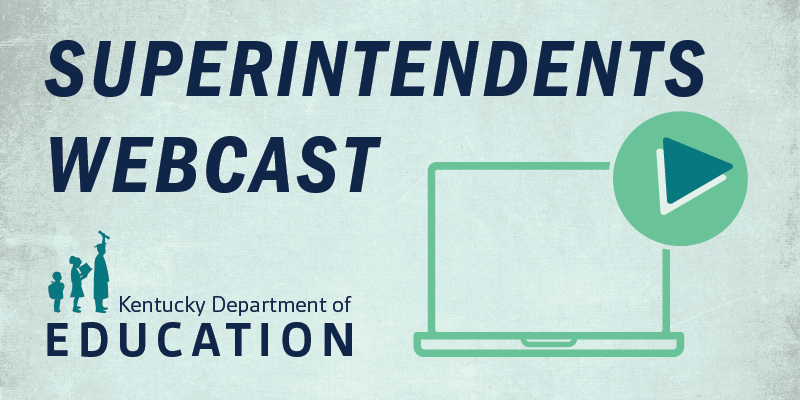
- Even though the guidance discussed in the July 22 PrAC meeting already has been released, Interim Commissioner Kevin C. Brown reiterated that this doesn’t mean guidance that has been issued won’t change as the pandemic evolves.
- With contact tracing, the role of the school will be to maintain student schedules, seating charts and bus manifests. These documents will be provided to contact tracers if there is a positive case.
By Jacob Perkins
jacob.perkins@education.ky.gov
Since the Kentucky Department of Education’s (KDE) Principal Advisory Council (PrAC) last convened on April 22, the department has released 15 guidance documents, but those documents could change as the pandemic evolves.
The guidance includes the flagship Healthy at School document, which was released in conjunction with the Kentucky Department for Public Health.
“In an ideal scenario, we would have all of these advisory meetings before guidance was issued. We don’t have that luxury in a time of emergency,” said KDE Interim Education Commissioner Kevin C. Brown. “Sometimes we’ve been able to get before advisory groups before we issued the guidance, other times we just don’t have that time.”
Brown told principals that KDE wanted to hear from them on things the department might not have thought of yet.
“Just because we’ve issued the guidance related to COVID-19 and all these areas that does not mean it’s written in stone,” he said.
On June 29, KDE released the “COVID-19 Considerations for Reopening Schools: Facilities and Logistics” guidance document.
That document provides information regarding cleaning and sanitation, changes to support social distancing, patterns for vehicular and foot traffic, and building security.
A key mitigation strategy to reopen schools involves maintaining a minimum 6-foot social distancing between students, teachers and staff as much as possible during the instructional day. To support schools and districts in achieving this goal, KDE included a room capacity calculator within the guidance.
The calculator allows districts to determine the capacity for rooms by inputting the room size in square feet and the percentage of usable space. The tool also can be used to determine the number of students allowed in other areas, such as the cafeteria.
Jennifer Hutchison, principal at Picadome Elementary (Fayette County), asked if the department recommends that schools remove smaller classroom tables used for small groups as a way to increase the usable space within a classroom.
Kay Kennedy of KDE’s Office of Finance and Operations said all of the mitigation strategies – such as social distancing – work together when trying to minimize the spread of COVID-19.
“If the table is actually equipped for four or five students sitting around the table and working with the teacher, you could drop that down to one or two and have them on separate ends,” said Kennedy. “If you can reduce the contact time, that’s also a helpful mitigation strategy. Before I removed the table from consideration for instruction this year, I would think about if there are ways that you could mitigate the techniques you’re going to use in your instruction.”
As for common areas such as gymnasiums where students formerly would gather, Kennedy says they still could be used if precautions are taken.
“If you have an assigned location … where you know students will go and sit and not … congregate in small groups, I’m confident you can make that work,” she said.
Kennedy added that the key to this will be having enough staff available to supervise the area.
Contact Tracing
The contact tracing program is an online tracking system that allows public health workers to record individual information of Kentuckians who have been exposed to COVID-19, conduct outreach and monitor wellness.
During a question and answer period, Mike Kelly, principal at Valley High School (Jefferson County), asked department officials for further clarification on the contact tracing program – specifically the role of the school.
“I’m just trying to get a good feel for what it actually looks like once we have a confirmed case,” he said.
Kennedy said the role of the school will be to maintain student schedules, seating charts and bus manifests. These documents will be provided to contact tracers if there is a positive case.
“Even though attendance is going to be treated a little different in terms of funding, we do need to know what students are in which classes and where they’re sitting,” she said. “My understanding is that once the health department is notified that there is a positive case, then the contact tracing will kick in.
“The school responsibility is really about where has that student been, who have they been in contact with, what’s the proximity of that student to other students because there are different levels of risks that may consequently result in a group of students, or even a classroom of students, needing to isolate for a period of time.”
The goal for contact tracing is not for the entire school building or the entire district to go into an isolation period, said Kennedy.
Other Guidance Discussed
- COVID-19 Considerations for Reopening Schools: Food Service Operations – USDA School Meal Programs
- COVID-19 Plan for Reopening Secondary Career and Technical (CTE) Facilities for Completion of Industry Certifications and Lab-Based Dual Credit Coursework
- COVID-19 Considerations for Reopening Schools: Pupil Transportation.
The PrAC will meet again on Oct. 8.
For more information about COVID-19:
- Kentucky Department for Public Health’s COVID-19 webpage
- KDE’s COVID-19 webpage
- KDE’s COVID-19 Reopening Resources webpage
- COVID-19 Hotline (800) 722-5725




Leave A Comment